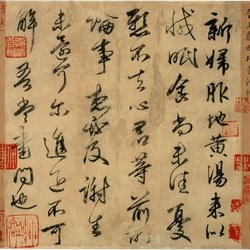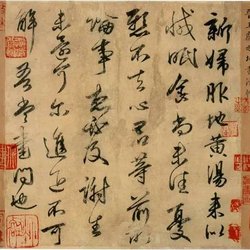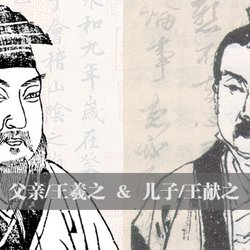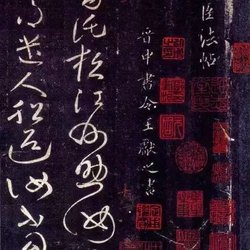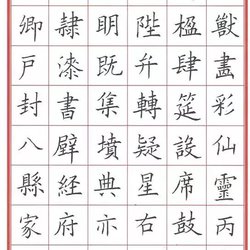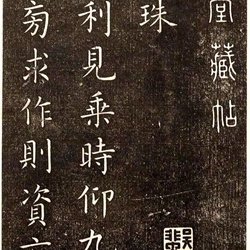Wang Xianzhi (344-386), courtesy name Zijing, was the seventh son of Wang Xizhi. He was an official in Zhongshu Ling and was known as "Wang Daling". In the Wang family of the Eastern Jin Dynasty, there are many people who are proficient in calligraphy. It can be said that calligraphy is passed down from father to son, brothers compete with each other, and everyone is diligent in learning and inheriting from each other. This not only represents the era of calligraphy consciousness in the history of Chinese calligraphy, but also presents a cultural era with brilliant stars.
Xianzhi died young (at the age of 43), but the title of the book is the same as that of his father and he is also known as the "Two Kings". He is also known as the "Four Sages" in the book together with Zhang Zhi, Zhong Yao and Wang Xizhi. Wang Xizhi had great expectations and strict requirements for Xianzhi. He personally wrote "Le Yi Lun" as a model for Xianzhi's calligraphy practice. He also accumulated a lifetime of calligraphy art creation experience and taught it to his son personally, so as to enlighten his understanding and promote his family learning. Wang Xianzhi lived up to his father's expectations and became talented and talented. Under his father's instruction, his calligraphy skills improved greatly. When he was young, Xian Zhi was extremely focused on studying books, and there is a legend that his father never took off his pen. In the later period of his calligraphy, he also adopted Zhang Zhi and made it into one. He is famous for his running script and cursive script, and his regular script, running script and cursive script are all excellent. In addition to inheriting the internal calligraphy techniques of Wang Xixi, he also innovated the external extension method and became his own brand. This caused later generations to be confused in the competition between the two kings to win the top spot in calligraphy.
From the Han Dynasty to the Wei and Jin Dynasties, everyone from the emperors to the common people respected calligraphy, and literati and poets were all proud of their good calligraphy. Zhao Yi of the Eastern Han Dynasty described people's obsession with calligraphy in "Fei-Cursive Script": "Dedicate yourself to the task, drill hard and look high, forgetting your fatigue. I am constantly alert at night, and I have no time to eat. I write one stroke in ten days and write ink every month. Leaders such as His lips and teeth are often black. Even though he is sitting in a crowd, he does not hesitate to talk about dramas. He stretches out his fingers to draw on the ground, scratches the walls with grass, scrapes his skin through his arms, breaks his fingers and claws, and sees bleeding from his gills, and he can't stop." It shows the attitude of the scholar class in the Eastern Han Dynasty. The mentality of cursive writing fanaticism. Zhang Zhi in the Han Dynasty was dubbed the "Grass Sage" because his works such as "Champion" and "All Years" conveyed his stunning aesthetic personality and creative passion. Jin Weiheng's "Four Types of Calligraphy" records: Zhang Zhi "Everyone who wears silk at home must write and then practice it; when he comes to the pond to study calligraphy, the pond water will be full of ink." Later generations called calligraphy "Linchi", which probably originated from this. Zhang Huaiguan's "Shu Duan" said that he "learned the methods of Cui (Yuan) and Du (Cao), and therefore changed them to become today's grass and refine it. The style of the characters is made up of one stroke, with occasional discontinuities. But if the blood vessels are continuous and connected, the Qi vessels are connected to other lines." People in the Han Dynasty cherished their calligraphy to the point of "spreading every inch of paper", which shows how enthusiastic the society was about calligraphy at that time.
The history of the development of calligraphy is a history of continuous exploration and innovation. Wang Xizhi's calligraphy is an important milestone in the transformation of Chinese calligraphy from the "ancient quality" aesthetic paradigm to the "modern beauty". Wang Xizhi put a lot of effort into the regular script and cursive script at that time, and integrated them on the basis of his predecessors. He reached a wonderful state in regular script, running script, cursive script, Li script, Ba Fen script, Fei Bai script and Zhang Cao script. "The debate at the time thought that Xi's Cao Li was no match for the Jiangzuo and Zhong Dynasties. The strength of his bones was far less than that of his father, but he was quite charming." ("Book of Jin·Biography of Wang Xizhi")
In my opinion, in the history of the development of calligraphy, Wang Xianzhi was dissatisfied with the Wei and Jin calligraphy's heavy brushwork and crude and simple structure. He took a unique approach, studied the calligraphy style carefully, and used solid traditional techniques and Jiajia's unique innovations. The posture transformed the simple calligraphy style since the Han and Wei dynasties into the natural, free and elegant cursive calligraphy style, promoting the advent of the conscious era of Chinese calligraphy culture.
Wang Xianzhi was quite like his father, free and elegant, and not constrained by worldly etiquette. Straightforward and sincere, fluttering like a giant. There are many records of his deeds:
"Shishuoxinyu·Words Second": Wang Zijing said: "Walking up from the mountain valley, the mountains and rivers complement each other, which makes people overwhelmed. It is especially difficult to remember in autumn and winter." It can be said that the literary talent is full of brilliance and the feelings are ancient.
"Book of Jin·Biography of Wang Xizhi" "(Hui Zhi) and Xian Zhi are both seriously ill. Sometimes people say: 'Human life should end, and if there are living people who are happy, the dead can live.' Hui Zhi said: 'I The talent and position are not as good as those of my younger brother, please use the remaining years to replace him.' The magician said: 'In the place of the deceased, I have more than one year to satisfy the deceased's ears. Now that the king and his younger brother are both exhausted, who can replace him!' Not long after, he died. Hui Zhi went to the funeral without crying. He went straight to the funeral bed and sat on the funeral bed. He took the offered harp and played it. For a long time, he could not tune it. He sighed and said: "Oh, Zijing, everyone is dead!" Because of this, he suddenly suffered from back disease, and then it burst. He died after more than a month."
"Book of Jin·Biography of Wang Xizhi": "When I was in the same room with Hui Zhi, I suddenly got angry and Hui Zhi ran away without missing a beat. Xian's expression was calm, and he called out to help him out. At night, there was a thief in the room. When they entered his room, they found all the stolen goods. Xu presented them and said: 'Too'er, I have some old things from my house that I can put here.' The group of thieves ran away in shock."
"Book of Jin·Volume 80·Biography No. 50": "When Xian was ill, his family members were the first chapter. The Taoist method should be the first to pass it over and ask him what he had gained and lost. He said to him: 'I don't know what happened, but I remember what happened to Xi. The family was divorced.'... He died in officialdom in Russia." I feel ashamed of myself for divorcing the Xi family.
——The tragedy of Wang Xianzhi’s marriage has caused the pain of his life to last for thousands of years and is heart-wrenching. His first wife was his cousin Xi Daomao (the daughter of his uncle Xi Tan). They had a deep relationship with each other. Later, because the emperor chose him as his consort, he forced Xianzhi to divorce Xi Daomao. Xianzhi escaped from the marriage by burning his own feet and becoming disabled, but he failed. Success, but had no choice but to let fate dictate and marry Princess Sima Daofu of Xin'an as his wife. This loveless marriage is extremely painful! "Feng Dui Tie" in "Chunhua Pavilion Tie" is a letter written by Wang Xianzhi to Xi Daomao after his divorce: "Although I have been with Dui Dui for many years, I can enjoy it all day long, but the pain will never be exhausted. Fang Yu and his sister How can we say we have to say farewell to each other when we are old together? We are deeply saddened, how can we see my sister day and night again? I look down and grieve, I have no regrets, I just have to give up my breath!" It hurts! His heart, body and mind were exhausted, so Xian died young at the age of 43, and his genius withered prematurely, which is regrettable!
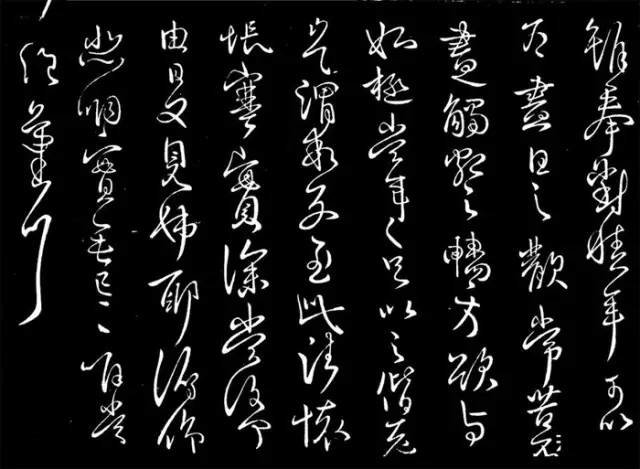
Wang Xianzhi's "Feng Dui Tie"
Wang Xianzhi was able to innovate while inheriting the calligraphy style of his father. When he was fourteen or fifteen years old, he once said to his father: "The ancient rules and regulations are not grand. Today's principles are poor and fake, and they are extremely careless. They are not as good as those in the past. Adults should change the style." He has felt that the fashion of simplicity, change and beauty must be combined with the "pseudo-abbreviation" of folk calligraphy and the indulgence of Zhang Cao to pursue a new style that is graceful, graceful, smooth and grand. In the huge shadow of his father's calligraphy, Wang Xianzhi bravely stepped out and created his own "Da Ling style" of Shenjun and Yanmei, which is the running cursive and large cursive between regular script and cursive script.
Wang Xianzhi's temperament is more unruly and unrestrained than his father's, and his calligraphy has a more bold and unrestrained momentum, and his writing is faster. Emotion plays a leading role in the movement of lines, and he begins to put momentum and rhythm before law and charm. romantic style.
Xianzhi's "one-stroke calligraphy" is more perfect than Zhang Zhi's "one-stroke calligraphy". His representative work "December Tie" started from regular script and quickly turned into cursive script with extraordinary momentum, flowing thousands of miles without any connotation. In a harmonious manner, the painting is filled with tension, joyful brushstrokes and vigorous and powerful emotional expression. It has a new sense of beauty that is different from that of the King.
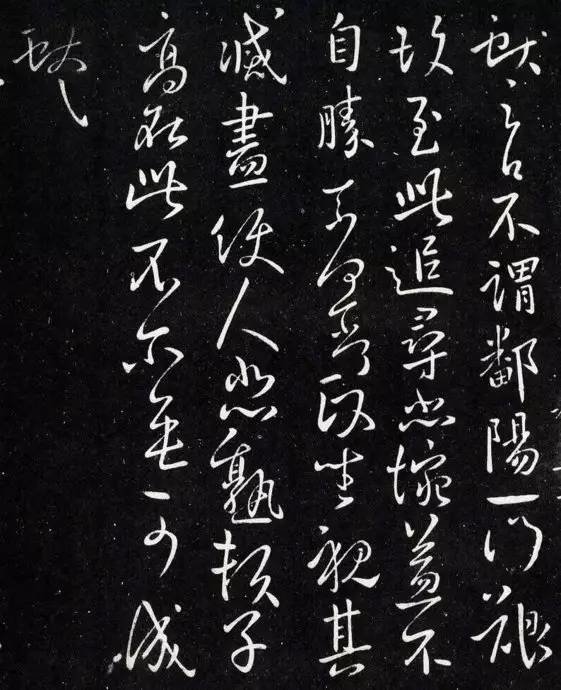
Wang Xianzhi's "Not a Tie"
Wang Xianzhi is very confident in his original "Da Ling Style" and "One Stroke Style". One time Xie An asked Wang Xianzhi: "How do you think your calligraphy compares with your father's?" The answer was: "Of course it is better than him!" Xie An said: "That's not what everyone thinks." Xianzhi replied: " How do ordinary people know?" ("Book of Jin·Biography of Wang Xizhi") Of course, Wang Xianzhi's words cannot help but be young and conceited. He has his own opinions on the difference between his own calligraphy and his father's. In his conceitedness, we can also see his innovative self-confidence. Wang Xianzhi was deeply influenced by his father, but he did not stick to the rules or cater to others, but maintained a strong innovative spirit and independent personality, which made his calligraphy reach another peak in the Jin Dynasty. Together with his father, Wang Xianzhi was known as the "Two Kings". It had a significant impact on calligraphy of later generations.
Wang Xizhi's seven sons and one daughter were all good calligraphers, but Wang Xianzhi was as famous as Wang Xizhi.
Shen Yinmo said in "A Glance at the Calligraphy of Two Kings": "The big king's calligraphy is internal and external, and the small king's calligraphy is external. The big king's calligraphy is strong and upright, beautiful and quiet; the small king's calligraphy is strong and soft, and the elegance is actually increased." The book of bones (qi) wins; the external expansion is the book of tendons (strength)." "The internal development is the ancient, the external expansion is the present. It is self-evident that the ancient quality is studied today."
A careful comparison of Xixian's brushes shows that Wang Xianzhi mostly used the internal brush strokes, and used the whirling edge to make the strokes smooth, while Wang Xianzhi mostly used the outer stroke brush strokes, which were vigorous and vigorous. Xizhi Nei's calligraphy emphasizes strength and is restrained and reserved, and his calligraphy has the elegance and beauty contained in the mean; while Xian's calligraphy is unbridled and unrestrained, his calligraphy emphasizes strength and is good at twisting the edge and turning downwards, and has a bright, broad and bold beauty. . Fengfang's "Shu Jue" of the Ming Dynasty said: "Youjun's brush strokes are mostly on the front, so the rules are strict and the spirit is immersive; Zijing uses the brush on the outside, and the side strokes are half, so the spirit is relaxed and wonderful."
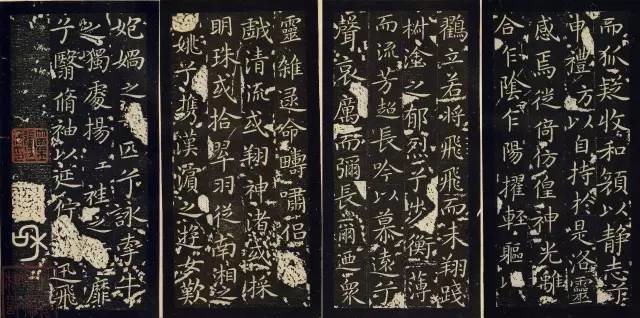
In his early years, Xianzhi learned about calligraphy by studying his father's "Le Yi Lun", and wrote "Luo Shen Fu" ("Thirteen Lines on the Jade Edition") in regular script, which inherited Wang Xizhi's calligraphy style. Vigorous, broad and graceful, it has become a representative work of Xianzhi's youth. The predecessors commented on Wang Xianzhi's "Thirteen Lines on the Jade Edition" as "the phoenix dances in the elixir hole and the dragon leaps in the clear spring. It is precise and skillful, stemming from the wisdom." The outline is extended with a pen, and the structure is well-proportioned and neat.
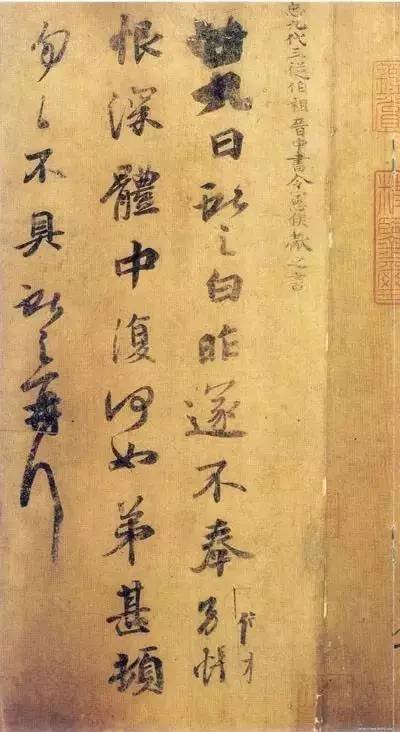
Wang Xianzhi's "Twenty-nine Days Post"
The representative work of regular regular script is "Twenty-nine Days Tie" (copy of Tang hook). The whole frame is stretched and generous, and the postures of sideways, vertical convergence, high and low, long and short are added to the square shape to increase the dynamic feeling of the characters. The regular script and cursive are mixed, and the writing is free, showing The writing style of the dedication is free and expressive.
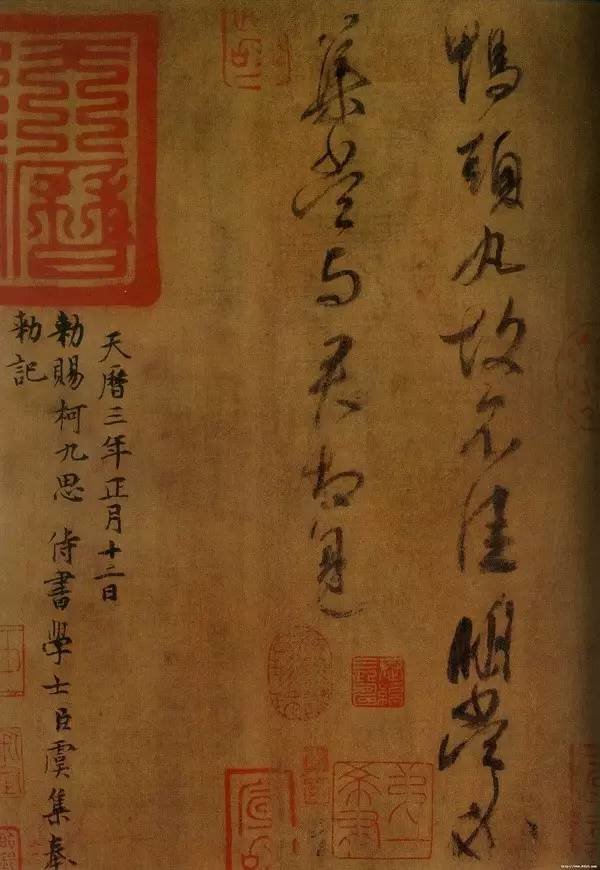
Wang Xianzhi's "Yatou Wan Tie"
The representative work of running cursive is "Yatouwan Tie", which is only two lines, neither straight nor cursive, and has a distinct personality. It is an authentic work handed down from generation to generation: "Yatouwan, so it is not good. I will gather it tomorrow and meet you." Fifteen lines in total. Character. This work fully demonstrates Wang Xianzhi's aesthetic concept of "drafting". In the natural writing of two dips in ink, the ink color changes from rich to dry, and the rhythm and rhythm changes are extremely natural and ethereal. Yu Zhuo once said: "Cursive calligraphy descended from Zhang Zhi of the Han Dynasty. The most wonderful person and divine person is just an official slave." Wu Qizhen of the Qing Dynasty highly praised this calligraphy in "Books and Paintings" and believed: "(This calligraphy) is elegant and upright, majestic and majestic." It is astonishingly beautiful and naturally interesting, and it is a supreme quality."
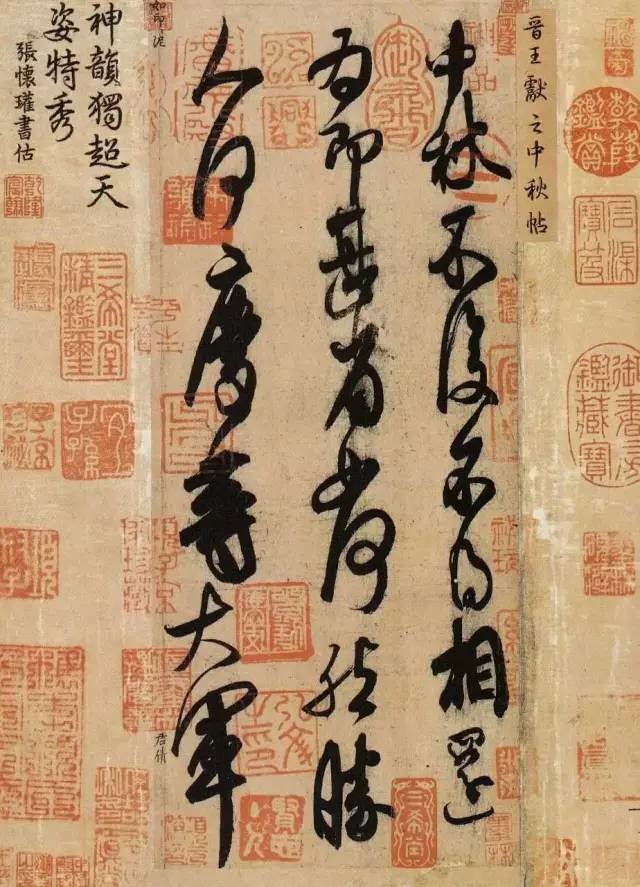
Wang Xianzhi's "Mid-Autumn Tie"
"Mid-Autumn Tie" is probably the result of Mi Fu's response to Wang Xianzhi's "Twelve Month Tie". Mi Fu collected the "December Tie" in Baojinzhai. He often watched it while he was writing it, and deleted ten characters that were not in harmony with the "one-stroke calligraphy". He dipped it in thick ink and wrote it down willfully, with continuous strokes. , like a surging river flowing thousands of miles, it becomes a vigorous and bold stroke of writing. Unfortunately, Mi Fulin's pen was too thick, which weakened the Qingqi and penetrating charm of the Wei and Jin Dynasties. Zhang Chou's "Qinghe Painting and Calligraphy Boat" of the Qing Dynasty said: "The volume of the "Mid-Autumn Tie" presented was hidden in the capital of Li Xiang's family. It has its own postscript. If you look closely, it is a copy of the Tang Dynasty copy, and it is not an authentic work." It can be said that it is a unique vision.
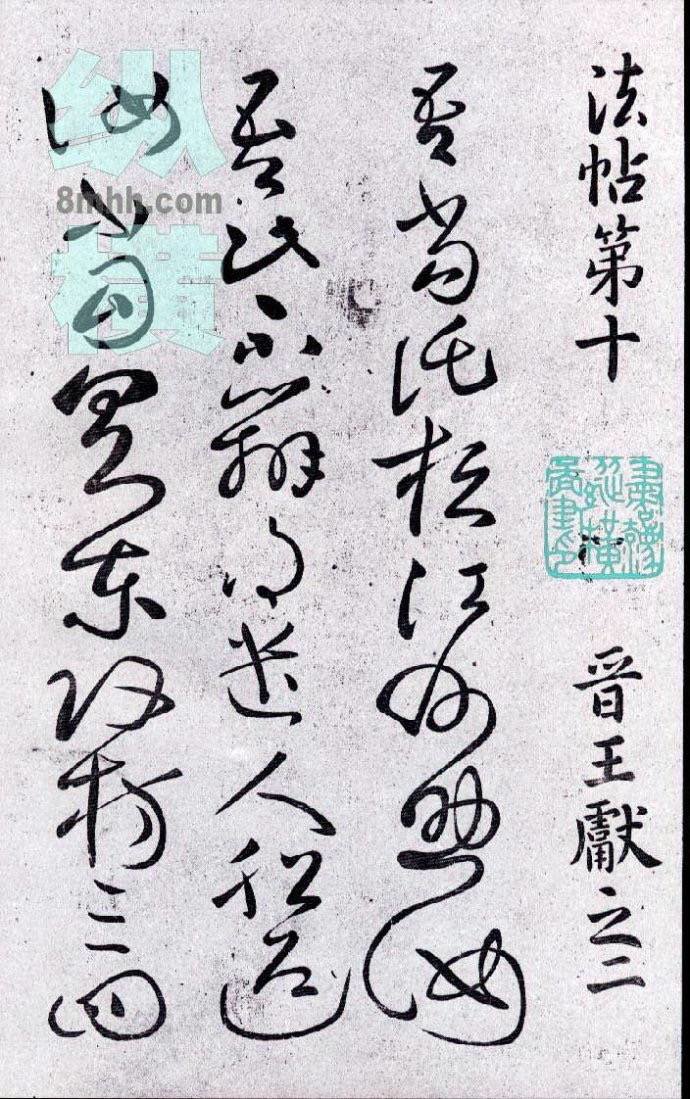
Wang Xianzhi's "Wu Dang Tie"
Another representative of several "one-stroke writings" is the "Wudang Tie" in the tenth chapter of "Chunhua Pavilion Tie": "I will ask Huanjiang Prefecture to help you, but I don't know how to send people and ships to welcome you. I should have Donggai (times) Fang three or four. I am a small person. I will have no lake to welcome you. Therefore, I can get fifty or sixty people. Xiao Fang. Thank you for your gratitude. If you have it, you will see it. Now I will explain it, and this is the end of Dali. The letters can be white one by one. The pain in the scar is unbearable. But if it is written as a record, it will be incomprehensible." Wang Xi changed the disconnected grass above and below into a connected grass, a coherent number, and momentum. Magnificent and heroic.
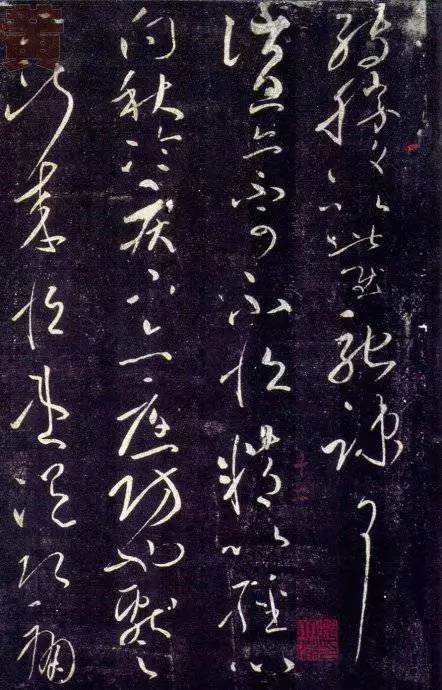
Wang Xianzhi's "Message Post"
Similarly, Wang Xianzhi's "News Post" "Messages must also be kept carefully and carefully. It is also necessary to prevent cold diseases in autumn. It will be cut off when presented. Constantly suffering from dampness and headache. Recover Xiaoer's ears." The brushwork is exquisite and the style is Magnificent. Wang Xianzhi's cursive scripts such as "Qing Deng Tie" and "Xuan Du Tie" all come out from all sides, with yin and yang facing away, and the wind and sea waves are unpredictable.
In the history of Chinese calligraphy, there has been a miracle of "a small king defeating a big king" - from the late Jin Dynasty to the Liang Dynasty for a century and a half, Wang Xianzhi's influence exceeded that of Wang Xizhi. Yuan Ang, a calligrapher and painter of the Liang Dynasty, said in "Ancient and Modern Book Reviews": "Zhang Zhi is amazing, Zhong Yao is extraordinary, Yi Shaoding is capable, and he is the best in the world." The four sages are called together. During the Song and Qi Dynasties, Wang Xianzhi was promoted to the highest status of Chinese calligraphy, and his reputation surpassed that of his father Xizhi. Liang Tao Hongjing's "Discussing Calligraphy with Emperor Wu of Liang" says: "Everyone in the world respects the calligraphy of Zizi." It was not until the Tang Dynasty, when Emperor Taizong of the Tang Dynasty praised Xi but demoted him that the history of calligraphy once again overthrew Wang Xizhi as the calligrapher.
Wang Xianzhi's ink writings are rarely preserved. "Chunhua Pavilion Calligraphy" records only 73 pieces of Wang Xianzhi's writings, and about 20 pieces are forgeries or written by others. In the smoke of history, most of Wang Xianzhi's ink writings have not been preserved. It can be preserved, and today we can see about seven ink-printed books, but they are all copies.
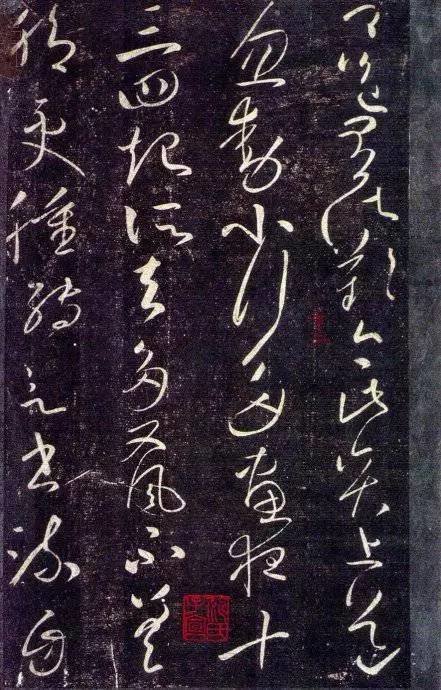
Wang Xianzhi's "Sudden Post"
To be fair, both Xi Xian and his son have reached a very high level in the history of Chinese calligraphy, and each has its own merits in brushwork and aesthetic style - Xi is best at true calligraphy, while Xian is best at cursive calligraphy. Not a single word of the two kings' original calligraphy has been preserved, and all the calligraphy handed down from generation to generation are copies. Wang Xizhi's calligraphy has been widely circulated, with about 250 pieces. Due to their great contribution to the innovation of calligraphy, Wang Xizhi and Wang Xianzhi, their father and son, are known as the "Two Kings". They have changed the past and the present and are unique in the calligraphy world. The calligraphy of the Jin Dynasty represented by the "Two Kings" represents the awakening of Chinese calligraphy and the unprecedented expression of calligraphy individuality, thus surpassing the calligraphy of the Han and Wei dynasties and becoming the twin peaks in the history of Chinese calligraphy.
Wang Xizhi's calligraphy style and calligraphy theory first influenced his descendants. The eldest son Xuan is good at cursive calligraphy, the second son Ning is good at gong cursive calligraphy, the third son Huan is good at cursive calligraphy, the fifth son Hui is good at cursive calligraphy, the sixth son Cao is good at cursive calligraphy, and the seventh son Xian is good at cursive calligraphy. Huang Bosi's "Dongguan Xu Lun" said: "Wang's four calligraphy works of Ning, Cao, Hui and Huan were passed down together with Zijing's calligraphy. They all have family styles, but their styles are different. Ning's calligraphy has its rhyme, and Cao's calligraphy has its own style. Its body, the emblem obtains its power, the radiance obtains its appearance, and the dedication obtains its origin."
Later, descendants continued, and Wang's calligraphy continued to thrive. In the Sui Dynasty, Wang Xizhi's seventh-generation grandson (Huizhi's sixth-generation grandson) Zhiyong, his calligraphy was still famous at home and abroad. Zhiyong's "Zhencao Thousand-Character Essay" had a great influence. His calligraphy inherited the ancestral method and he practiced calligraphy diligently, so the name of the book became popular. According to legend, Zhiyong lived in Yongxin Pavilion for 30 years and wrote more than 800 copies of "Zhencao Qianzi Wen", which were presented to various temples in eastern Zhejiang. Several jars were filled with bald brushes. The ink in "The Thousand-Character Essay" is inspired by the spirit of the two kings. It is exquisite in pointillism, gentle in brushwork, and rigorous in structure, showing a sense of skill. At that time, there were so many people asking for letters and plaques that the threshold where they lived was trampled through, so they had to be covered with iron sheets, which was called the "iron gate". "Shu Duan" believes that it is "capable of all styles, and is the best in cursive script". Listed cursive script and cursive script are classified as Miaopin, and official script is classified as Nengpin. Su Shi's "Dongpo Inscriptions and Postscripts" of the Song Dynasty believed: "Yong Zen Master's calligraphy has a deep and hidden character, a body that combines many wonderful things, and is extremely capable, yet it is sparse and sparse in its creation." Most of his calligraphy and calligraphy have not been handed down. Among the surviving handwritings are "Imitation of Zhong Yao's Announcement" and "Zhencao Thousand-Character Essay" collected in Japan.
In contemporary calligraphy creation, we should turn back from the lost path, firmly return to the classics and enter the Wei and Jin Dynasties, and feel the eternal charm of the classics in the beauty and magnificence of the calligraphy style of the two kings!

